 S3 Trio Series (1994-1998)
S3 Trio Series (1994-1998)
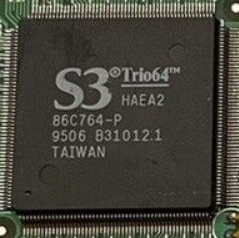
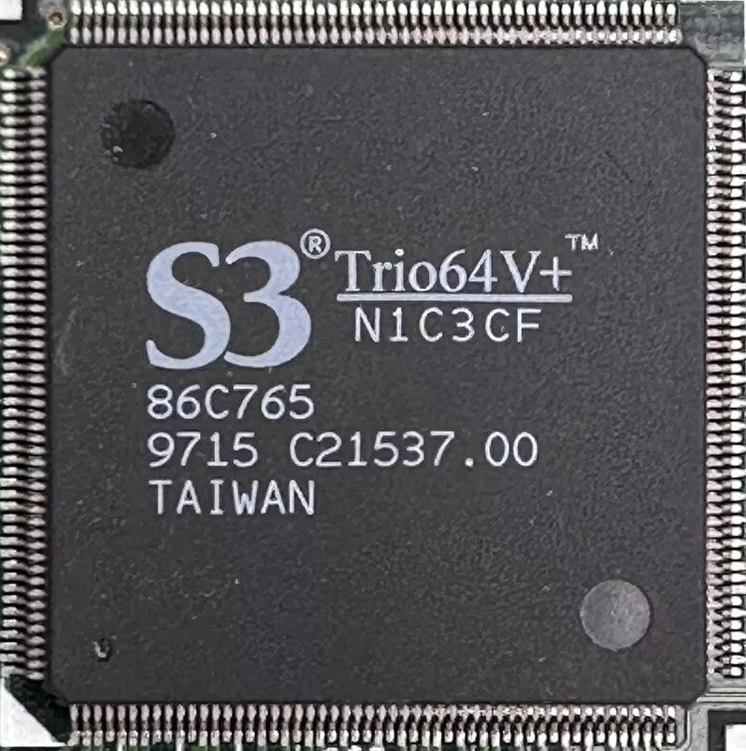
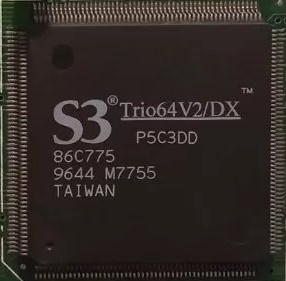
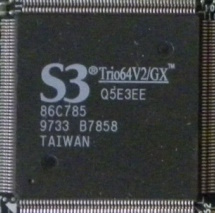
From left: Trio64 (1994), Trio64V+ (1995), Trio64V2/DX (1996), Trio64V2/GX (1996)
Summary
| Launched | 1994 | VESA Support | Yes, VESA VBE 2.0 in BIOS, VESA Advanced Feature Connector (VAFC) |
| Bus Type | PCI v2.1 or VESA Local Bus | API Support | DirectX 5.0, BRender, RenderWare, and OpenGL |
| Chipset | Trio64 (86C764) or Trio32 (86C732) | Found on Cards | ELSA Trio64 ELSA Winner 1000 Diamond Stealth 64 VLB DRAM A-Trend ATC-2125 Paradise Bahamas 64/64VL STB Powergraph 64 PCI V7/Spea Mirage P64 DataExpert CP764 Fastware Winfast S280 Number Nine GXE64 Trio |
| Core Clock | 135 MHz (Trio32, Trio64 and Trio64V+) 170 MHz (Trio64V2/DX and Trio64V2/GX) 230 MHz (Trio3D and Trio3D/2X) |
||
| Memory | 1 MB, 2 MB or 4 MB of FPM or EDO DRAM | ||
| Memory Speed | 40 MHz - 66 MHz | ||
| RAMDAC | 24-bit TrueColor (integrated) | Competitors | S3 ViRGE/GX SiS 6326 nVidia RiVA 128 3d Labs Permedia 2 Rendition Verite 2100 Number Nine Ticket to Ride Matrox Millennium G200 Matrox Mystique 220 |
| RAMDAC Speed | 135 MHz - 170 MHz |
Introduction
The Trio range of integrated graphics accelerator chipsets began life in the form of the Trio64 (S3 86C764) and Trio64V+ (S3 86C765) in 1994 and mid-1995 respectively - S3 took their highly successful earlier Vision864 and Vision868 chips, and integrated a 24-bit RAMDAC onto the die. Functionally, the Trio64 was similar to the Vision964 while the Trio64V+ aligned with the Vision968. Having been first announced in September 1994, the first card to hit the market that used the Trio64 was STB Systems Powergraph 64 PCI in December of that year, shortly followed by the Diamond Stealth 64 DRAM in January 1995. Trio was targeted at the consumer market, whereas the Vision968 series continued to sit among their professional offerings. The Trio64V+ added hardware support for full motion video via its S3 Scenic Highway interface, a local peripheral bus (LPB) into which you could connect the optional S3 Scenic/MX2 MPEG-1 audio/video decoder (also Philips SAA7110/SAA7711 video digitisers).
Trio32 (S3 86C732) was introduced alongside the Trio64 as a cut-down cost-effective version of its 64-bit brother, with its 32-bit wide memory access path and memory limited to 2 MB. Some cards that used the Trio32 include the Video 7/Spea Mirage P32, miro microCrystal 12SS, Diamond Stealth SE, STB PowerGraph 32, and DFI S3 Trio32.
The Trio64V2 followed two years later in 1996. It came in two forms: Trio64V2/DX (S3 86C775) and Trio64V2/GX (S3 86C785), with the former still using DRAM memory and the latter able to use the newer, faster synchronous SDRAM and SGRAM technology. Both the DX and GX added vertical bilinear filtering, a 170 MHz RAMDAC, and was capable of displaying at up to 83 Hz vertical refresh rate at 1280 x 1024 (up from 72 Hz on the Trio64 and Trio64V+) or 60 Hz refresh rate at 1600 x 1200 non-interlaced.
The Trio64V2 extended the functionality of the Trio64V+ with the introduction of S3's "Enhanced Streams Processor" architecture, which allowed for the mixing of up to three separate display streams. This handled on-the-fly stretching/blending of the primary RGB video stream, secondary RGB/YUV (video) stream, and a hardware cursor, with upscaling, colour space conversion, and contrast/brightness/saturation control. The V2 came with hardware acceleration for video up to 1024 x 768 at 16-bit colour depths and at high frame rates, and supported all the popular video encoding standards at the time such as Indeo, Cinepak and MPEG-1, though the latter was only accelerated in software.
In late 1997, S3 released their first true 3D graphics accelerator, the Trio3D (S3 86C365). This supported up to 4 MB of memory and came with a single onboard pixel shader and a texture mapping unit. Its maximum resolution was 1600 x 1200 in 64,000 colours non-interlaced. All this at an impressive 85 Hz refresh rate thanks to its fast 230 MHz integrated RAMDAC. It was followed by the Trio 3D/2X (S3 86C368) about a year later, which doubled the supported memory size to 8 MB and leveraged system memory for texturing (an odd architecture choice since 8 MB should have been more than enough for both frame buffer and textures). It was also their first accelerator to support AGP 2x alongside PCI 2.1. While Trio 3D/2X was an improvement in terms of 3D compatibility (they removed the multiplicative alpha blending that was problematic on the Trio3D), however, it was a poor performer for early 1999 (outperformed even by S3's own ViRGE/GX), largely based on the outdated ViRGE while S3 frantically continued work on Savage3D.
A summary of the Trio range is listed below:
- Trio64 (86C764) - first version of the chip, launched in late 1994. PCI or VESA Local Bus only. It had two part numbers: 86C764 and 86C764X which was a mildly updated version, though functionally identical.
- Trio64V+ (86C765) - launched alongside Trio64. Added a video acceleration engine with MPEG-1 support for YUV to RGB colour space conversion and horizontal linear filtered scaling.
- Trio64UV+ (86C767) - the same as Trio64V+, but implemented a Unified Memory Architecture (UMA) which shares system memory between the host CPU and the graphics/video subsystem. Designed for embedded applications, such as for motherboards with onboard graphics or laptops/notebooks. It supported between 512 KB and 2 MB of frame buffer, did lost support for single-cycle if EDO DRAMs were used.
- Trio32 (86C732) - cost-effective variant launched at the same time as Trio64, with 1 MB or 2 MB DRAM on a 32-bit memory path. Same 135 MHz RAMDAC as Trio64/64V+.
- Trio64V2/DX (86C775) - Pin-compatible with the Trio64V+ (in both FPM and EDO) and BIOS and driver backward-compatible with V+. Added bilinear filtering, faster RAMDAC, higher resolution support over Trio64/64V+. Uses DRAM memory.
- Trio64V2/GX (86C785) - Same as V2/DX but uses faster SDRAM or SGRAM memory.
- Trio3D (86C365) - their first 3D graphics accelerator, with 1 pixel shader and 1 texture mapping unit. Maximum memory was 4 MB.
- Trio3D/2X (86C368) - supported AGP2x but still only got the 1 pixel shader and 1 TMU. Maximum memory increased to 8 MB.
Here's a comparison table of the Trio series compared to the Vision series that came before it:
| Vision864 | Vision868 | Trio64 / 64V+ | Trio32 | Trio64V2/DX & V2/GX | Trio3D | Trio3D/2X | |
|---|---|---|---|---|---|---|---|
| Release Date | Feb 1994 | Feb 1994 | 1994 / 1995 | 1994 | 1996 | Nov 1997 | 1999 |
| Chip | 86C864 | 86C868 | 86C764 | 86C732 | 86C775 / 86C785 | 86C365 | 86C368 |
| Bus | VLB/PCI | VLB/PCI | VLB/PCI | PCI | PCI | PCI, AGP 1x | PCI, AGP 2x |
| Core Clock | 60 MHz | 60 MHz | 60 MHz | 60 MHz | 60 MHz | 100 MHz | 100 MHz |
| RAMDAC Clock | 60 MHz | 60 MHz | 135 MHz | 135 MHz | 170 MHz | 230 MHz | 230 MHz |
| Memory Types | FPM | FPM | FPM or EDO | FPM or EDO | FPM/EDO (DX) SDRAM/SGRAM (GX) |
EDO or SGRAM | SDRAM |
| Memory Bus Width | 64-bit | 64-bit | 64-bit | 32-bit | 64-bit | 64-bit | 64-bit |
| Memory Sizes | 1, 2 or 4 MB | 1, 2 or 4 MB | 1, 2 or 4 MB | 1 or 2 MB | 1, 2 or 4 MB | 2 or 4 MB | 4 or 8 MB |
| Memory Clock | 50 MHz | 50 MHz | 55 - 70 MHz | 55 - 60 MHz | 60 MHz | 90 - 100 MHz | 100-110 MHz |
| Memory Bandwidth | 240 MB/s | 240 MB/s | ? MB/s | ? MB/s | 480/528 MB/s | 800 MB/s | 800 MB/s |
Since the Trio range were sold at budget prices, they found their way into many OEM builds. In summary for today, Trio3D and even Trio3D/2X should not be considered a viable option for 3D gaming, but all will run 2D games well. S3 cards these days are really only considered for DOS gaming, since their compatibility in DOS was excellent.
Supported Graphics Modes
The original Trio64 and Trio64V+ support resolutions up to 1600 x 1200. The table below outlines the vertical refresh rates available at each resolution:
| Resolution | 640x 480 | 800x 600 | 1024x 768 | 1280x 1024 | 1600 x 1200 |
| 16 colours | 60 | 56, 60, 72, 75 | 44i, 60, 70, 75 | 44i | - |
| 256 colours | 60, 72, 75, 85*, 100* | 56, 60, 72, 75, 85*, 100* | 44i, 60,70, 75, 85*, 100* | 44i*, 60*, 72* ,75* | 50i* |
| 65K colours | 60, 72, 75, 85*, 100* | 56, 60, 72, 75, 85*,100* | 44i*, 60*, 70*, 75* | - | - |
| 16.7M colours | 60, 72, 75, 85*, 100* | 56*, 60*, 72*, 75* | - | - | - |
i = interlaced
The Trio64V2 chips (V2/DX and V2/GX) supported these maximum vertical refresh rates:
| Resolution | 640x 480 | 800x 600 | 1024x 768 | 1152x 864 | 1280x 1024 | 1600 x 1200 |
| 256 colors | ? | ? | ? | ? | 85* | 60* |
| 65K colors | ? | ? | 85* | ? | ? | ? |
| 16.7M colors | ? | 85* | ?** | - | - | - |
**4 MB memory required
VESA VBE (Video BIOS Extensions) 2.0 was built-in, and S3 had their own VESA driver called S3VBE, though these days you can use UNIVBE or similar.
Memory
The original Trio64 and Trio64V+, launched in 1994 and early 1995 respectively, supported 1, 2 or 4 MB of either Fast Page Mode (FPM) or the then-new Extended Data Out (EDO) DRAM. These could be configured as 256Kx4, 256Kx8 or 256Kx16, and were typically 45ns which meant its memory ran at 70 MHz. For cards that used slower 60ns DRAMs, these had a memory clock of 55 MHz. It's worth mentioning that 1 MB versions of these can only use half the 64-bit memory interface, so expect Trio32 performance on a 1 MB Trio64 card.
The cut-down Trio32 used a 32-bit memory pipeline instead of the Trio64's 64-bit, resulting in half the memory bandwidth. Cards based on the Trio32 were also limited to a maximum of 2 MB video memory so the highest resolution supported by these cards was 1280 x 1024 in 256 colours.
The Trio64 V2/DX (launched in 1996) was similar to the original Trio32 and Trio64 chipsets in its use of either Fast Page Mode (FPM) or Extended Data Out (EDO) DRAM. However, when EDO DRAMs were used, the V2/DX operated in what is called "single-cycle mode", meaning just one memory cycle to read/write to the frame buffer. This resulted in much higher performance, linearly increasing peak bandwidth as the speed of the memory increased - 320 MB/sec with 40 MHz memory, 400 MB/sec with 50 MHz, and 480 MB/sec with 60 MHz (which was its maximum supported speed).
The Trio64 V2/GX (also 1996) did away with FPM and EDO support, replacing it with synchronous DRAM (SDRAM or SGRAM). At its maximum memory speed of 66 MHz, peak bandwidth reached 528 MB/sec.
They returned to single-cycle EDO support with the Trio3D, whose memory ran at 75 MHz, though it also supported 100 MHz SGRAM with block write functionality.
The Video BIOS
A number of BIOS versions exist for the Trio series, and while S3 wrote their own base BIOS, graphics card manufacturers often customised these. I have listed the ones I know in the table below, and have a few BIOS ROM dumps in the Downloads section further down.
| Chipset | BIOS Version | Card (or S3 BIOS if reference ver) |
|---|---|---|
| Trio32 | 1.02 | Diamond Stealth SE |
| Trio32 | 1.3-08 (22nd December 1994) | S3 BIOS |
| Trio32 | 1.4-04 (24th July 1995) | S3 BIOS |
| Trio64 | 1.02.01U | Number Nine GXE64 Trio |
| Trio64 | 1.2 | STB PowerGraph 64 PCI |
| Trio64 | 1.4 | ? |
| Trio64 | 1.5-07 EDO (27th September 1995) | S3 BIOS / ExpertColor DSP3364P |
| Trio64 | 2.03.10 (based on S3 1.3-08) | Number Nine 9FX Vision 330 |
| Trio64 | 2.05 | Diamond Stealth 64 DRAM |
| Trio64 | 2.09 (31st October 1995) | Diamond Stealth 64 DRAM |
| Trio64 | 2.24 | ELSA Trio64 |
| Trio64V+ | 1.01-05 (29th September 1995) | S3 BIOS / Octek Mirage 64 |
| Trio64V+ | 1.01-06 (29th September 1995) | S3 BIOS |
| Trio64V+ | 1.02-02 (16th September 1996) | S3 BIOS |
| Trio64V+ | 1.02-02 (20th December 1996) | S3 BIOS / SurfMedia Thunder |
| Trio64V+ | 1.03 | Diamond Stealth64 Video 2001 |
| Trio64V+ | 1.03-06 (1st June 1996) | S3 BIOS |
| Trio64V+ | 1.03-08N (3rd September 1996) | S3 BIOS |
| Trio64V+ | D2g (19th September 1997) | Hercules Graphite Terminator 64/Video |
| Trio64UV+ | 1.00-06 (14th October 1996) | S3 BIOS |
| Trio64V2/DX | 1.01.04 EDO | ExpertColor CP765 |
| Trio64V2/DX | 6.01.00 | ELSA Winner 1000/T2D |
| Trio3D | 2.0B.07 (10th June 1998) | S3 BIOS |
| Trio3D/2X | 2.0C.0983 (16th February 1999) | S3 BIOS |
| Trio3D/2X | 2.0C.10 (15th March 1999) | S3 BIOS |
| Trio3D/2X | 2.0C.10A (15th March 1999) | S3 BIOS |
According to some sources online, the Trio64V+ BIOS can be swapped out with a ViRGE BIOS without any issues.
The S3 Brightness Issue (a.k.a. S3 Black Pedestal issue)
Many ViRGE and Trio3D cards suffer from an issue where blacks appear grey - this is caused by timing settings in the video registers being set incorrectly by default. A fix was posted on the Vogons forum here, that involves running several commands in DEBUG that patch it:
C:\DOS\DEBUG.EXEo 3c4 08
o 3c5 06
o 3c4 27
i 3c5
<at this step subtract 08h from given value>
o 3c5 <resulting_value>
q .
Vogons user Jepael put this code into a couple of simple DOS utilities, which can be downloaded here.
Upgrades and Successors
Between the release of the first Trio64 chip in late 1994 and the Trio3D in late 1997, S3 themselves launched the ViRGE (Virtual Reality Graphics Engine) series in 1996. These were more focussed on 3D, and S3 created their own API for developers called S3d which provided both high performance 2D acceleration and 3D flat and Gouraud shading, texture mapping, perspective correction, bilinear and trilinear texture filtering, MIP mapping, depth cueing and fogging, alpha blending, and z-buffering. ViRGE also supported other popular 3D APIs including Direct3D, BRender, Renderware, and OpenGL. In addition to being a 2D and 3D graphics accelerator, ViRGE also leveraged the video acceleration features of the Trio64V+, including the S3 Streams Processor and S3 Scenic Highway. The first ViRGE arrived in 1996 with cards that used 2 MB or 4 MB of EDO DRAM.
About a year later, they introduced the ViRGE/VX which used 2, 4 or 8 MB of VRAM and got a 220 MHz RAMDAC over the 135 MHz of the original ViRGE (which was rebranded ViRGE/DX to signify its use of DRAM). S3 made significant updates to the 3D engine in both the DX and VX over the original ViRGE, with perspective correction now separated so it no longer caused unncessary clocks on the pipeline, and they implemented a new texture filter which was able to sample from different mip-maps.
Reception
The Trio series were marketed to be very cost-effective, with recommended pricing of the first Trio64 cards at around $250. The actual retail price of such cards varied of course, but started at $165 for 1 MB card, rising to $210 for a 2 MB variant. Compared to its direct competitors such as the ATI mach64 GX, this was indeed cheap. The mach64 GX used pricier VRAM, so a 2 MB card would cost closer to $370, and 4 MB card more like $570. Despite this, real-world benchmarks at the time showed the Trio64 to be the marginally better-performing of the two.
To a degree, Trio64 competed with its forebears, the Vision864 and Vision964, both of which were hugely popular in 1994 and early 1995. Other competitors in the graphics accelerator chipset market at the time the first Trio64 arrived included the Tseng Labs ET4000/W32p, Cirrus Logic CL-GD5434, Matrox MGA, C&T 64300 Wingine, and the Weitek Power 9100. The Matrox MGA's 2D graphics performance was still ranked at the top, as well as the aforementioned ATI mach64 GX, though the Trio64 wasn't too far behind these, and scored higher numbers than Tseng, Cirrus Logic, C&T and Weitek. It was a time when both VLB and PCI cards were prevalent, and the latter with its 66 MHz bus meant PCI was the future for graphics accelerators.
Sadly image quality with the Trio64 was not up to the standard we came to expect from higher-priced competing cards like the ATI Graphics Pro Turbo (which uses the mach 64 GX) and Matrox MGA.
The Trio64 series all had exceptional DOS compatibility but Windows drivers were known to be buggy throughout the Trio's long timeline.
Images
S3 Trio64 1 MB EDO card (Diamond Stealth 64 DRAM Rev.B1):
The Diamond Stealth 64 DRAM came either with 1 MB or 2MB installed. This one has 1 MB of 60ns EDO DRAM soldered-in with the option of expanding it to 2 MB via the two SOJ memory sockets.
S3 Trio64V+ 1 MB EDO card (STB PowerGraph 64 Video Rev.C):
.png) |
.png) |
.png) |
Model and Part #: STB PowerGraph 64 Video (1X0-0360-007) Main Chip: S3 Trio64V+, dated Week 42, 1996 RAM: 1 MB Mitsubishi M5M44265CJ (50ns) BIOS Chip: Unknown brand, labelled "PG 64V RL 2.0" |
The STB PowerGraph 64 Video came either with 1 MB or 2MB installed. This one has 1 MB of nice fast 50ns EDO DRAM soldered-in (Mitsubishi call this 'Hyper Page Mode' but it is EDO, not FPM) with the option of expanding it to 2 MB via the two SOJ memory sockets. The 50ns memory installed here is the fastest you can go with a Trio64V+.
S3 Trio64V+ 2 MB EDO card (Leadtek Winfast S280):
The Leadtek Winfast S280 here came with an additional 1 MB installed into the sockets. The 1 MB soldered-in is from Alliance Semiconductor (a quality brand), while the socketed SOJ chips are from TMTech (unsure about quality/reliability of these). All are 50ns, which is good.
S3 Trio64V+ 2 MB EDO card (Video Technology Computers ):
.jpg) |
.jpg) |
.jpg) |
Model and Part #: VTC Trio64V+ Main Chip: S3 Trio64V+, dated Week 10, 1997 RAM: 2 MB Alliance Semiconductor AS4C256K16E0-60JC (60ns) BIOS Chip: Unknown brand, labelled "EPOCH" |
The VTC Trio64V+ here came with an additional 1 MB installed into the sockets. The 1 MB soldered-in is from Alliance Semiconductor (a quality brand), while the socketed SOJ chips are from TMTech (unsure about quality/reliability of these). Sadly they are 60ns memory ICs, so will take a bit of a performance hit over the more common 50ns ones seen on Trio64V+ cards.
S3 Trio64V2/DX 1 MB EDO card (S3 Test Board):
.jpg) |
.jpg) |
| Model and Part #: S3 ST-775A Rev.A Main Chip: S3 Trio64V2/DX, dated Week 44, 1996 RAM: 1 MB Nippon NN514265J-60 (60ns) BIOS Chip: Unknown brand, labelled "Color Max Multimedia Acceleration" |
This Trio64V2/DX came with the base 1 MB soldered-in, and is believed to be a test board manufactured by S3 themselves. The memory is from Nippon (NPN), and is EDO DRAM memory. Sadly they are slow 60ns memory ICs, so will take a bit of a performance hit over the more common 50ns ones seen other cards here.
S3 Trio64V2/DX 4 MB EDO card (Gainward 2TheMax):
.png) |
.png) |
| Model and Part #: Gainward 2theMax (FCC ID: ICUVGA-GW503B) Main Chip: S3 Trio64V2/DX, dated Week 28, 1997 RAM: 2 MB Mosel Vitelic V53C16258HK35 (35ns) BIOS Chip: Unknown brand, labelled "2theMax" |
This Gainward 2theMAX card came with the full complement of 4 MB soldered-in. The EDO memory is really fast too, rated at 35ns.
S3 Trio64V2/DX 2 MB EDO card (ELSA Winner 1000/T2D):
.png) |
.png) |
| Model and Part #: ELSA Winner 1000/T2D (FCC ID: KJGW1000T2D) Main Chip: S3 Trio64V2/DX, dated Week 52, 1996 RAM: 2 MB Mosel Vitelic V53C16258HK40 (40ns) BIOS Chip: Unknown brand, labelled "2theMax" |
This ELSA Winner 1000/T2D card came with 2 MB soldered-in, and does not have any standard memory sockets to expand it to 4 MB - it may be that the S2 and S3 headers allow for a custom ELSA memory module, as these don't appear on other Trio64V2 cards. The EDO memory is however, really fast, rated at 40ns - just a bit slower than the Gainward card above.
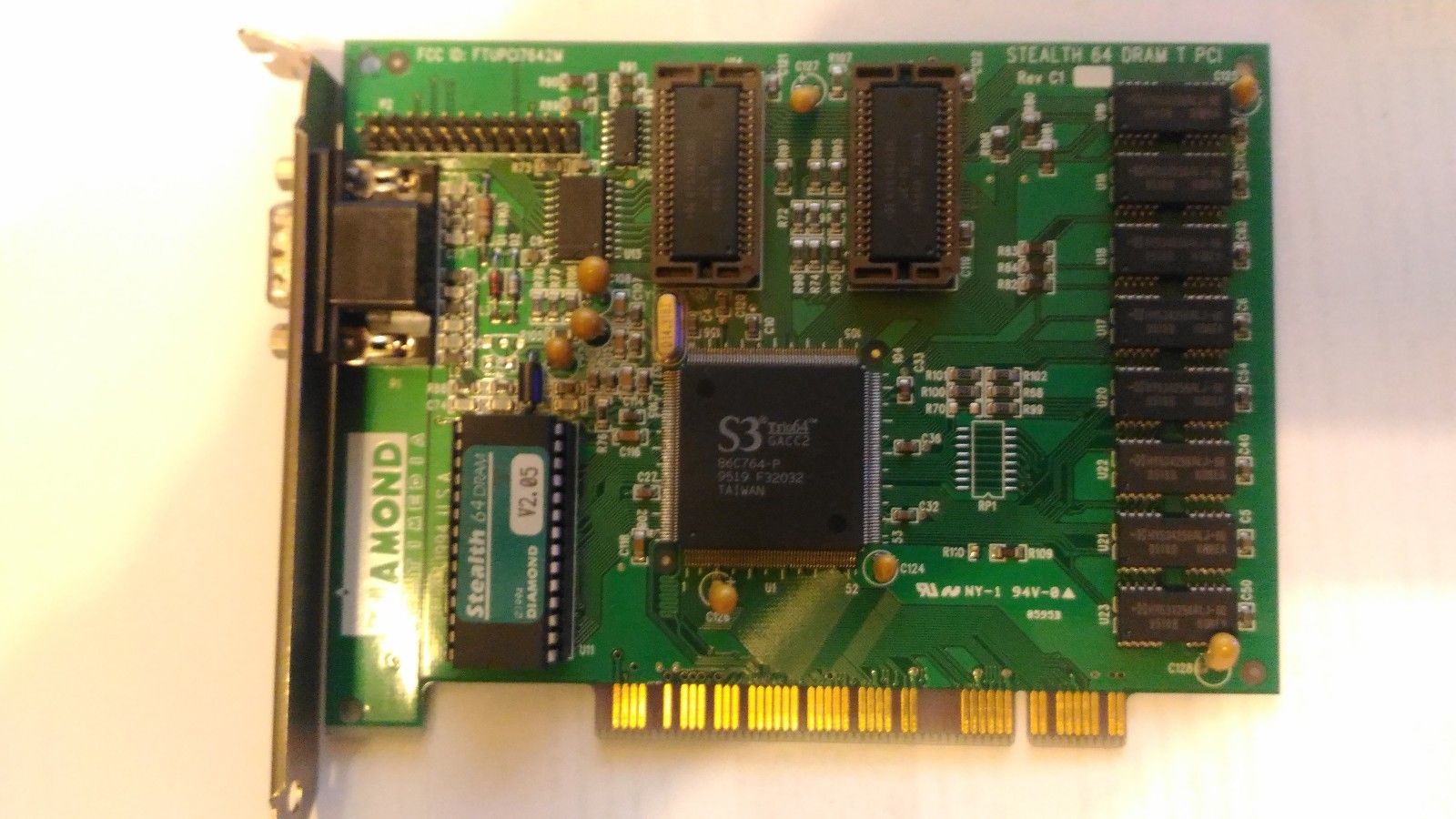
Diamond Stealth 64 DRAM PCI
with Trio64 (1995)
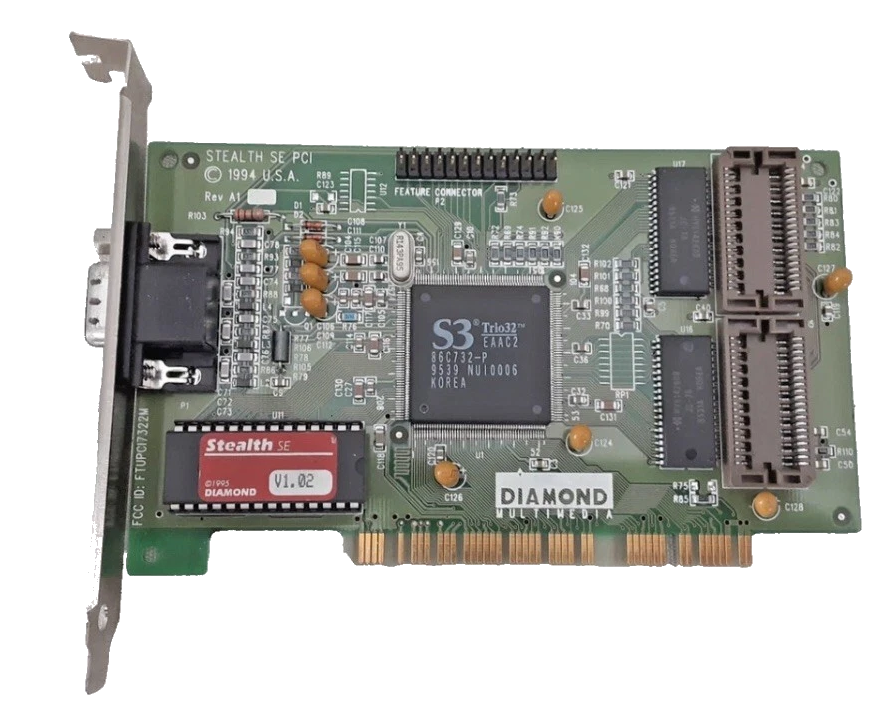
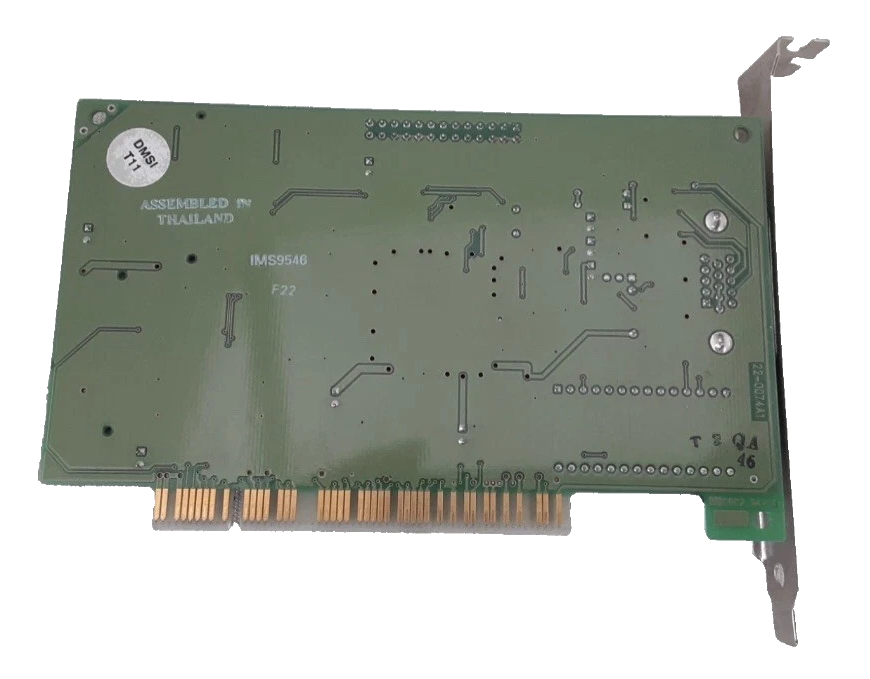
Diamond Stealth SE PCI
with Trio32 (1995)
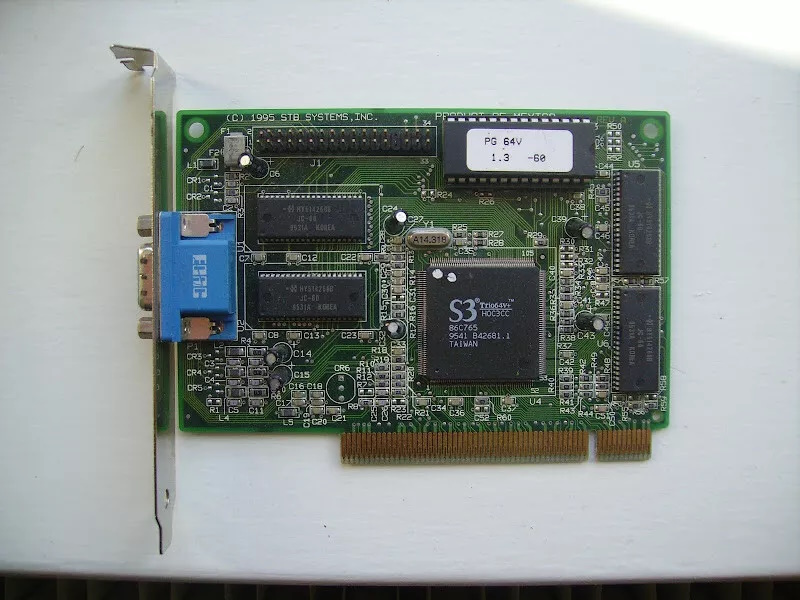
STB Systems PowerGraph 64 Video with S3 Trio64V+ (1995)
.jpg)
The S3 Scenic/MX2 Audio/Video Decoder daughterboard (1995)
Downloads
Trio64 Product Overview The original product overview from S3 |
Trio32/64 Datasheet The original datasheet for both the Trio32 and Trio64 from S3 |
Trio64V+ Product Overview The original product overview from S3 |
Trio64V+ Datasheet The original datasheet from S3 |
Trio64UV+ Datasheet The original datasheet from S3 |
Trio64V2 Product Overview The original product overview from S3 |
Scenic/MX2 Product Overview The original product overview from S3 |
Trio64 ROM BIOS VGA ROM BIOS for original Trio64 |
Trio64V+ ROM BIOS VGA ROM BIOS for original Trio64V+ |
Windows 3.1 Drivers S3 Flat Model Windows Trio765 (Trio64V) Driver for Windows 3.1, with resolutions up to 1600 x 1200. |
Windows 3.1 Drivers S3 Flat Model Windows Trio765 (Trio64V) Driver for Windows 3.1, with resolutions up to 1600 x 1200. |
Windows 3.1 Drivers S3 Flat Model Windows TrioV2 driver for Windows 3.1. |
Windows 3.1 Drivers S3 Flat Model Windows Trio765 (Trio64V), 775/785 (Trio64V2/DX and GX) Driver for Windows 3.1, with resolutions up to 1600 x 1200. |
Windows 3.1 Drivers S3 Flat Model Windows Trio3D driver for Windows 3.1. |
Windows 3.1 Drivers S3 Flat Model Windows Trio3D-2X driver for Windows 3.1. |
Windows 95 Drivers Win95 driver for many older S3 cards including 911, 801, 928, 864, 868, 964, 968, 764 (Trio64), and 765 (Trio64V+) |
Windows 95 Drivers Win95 driver for many older S3 cards including 911, 801, 928, 864, 868, 964, 968, 764 (Trio64), and 765 (Trio64V+) |
Windows 95 Drivers Win95 driver for many older S3 cards including 911, 801, 928, 864, 868, 964, 968, 764 (Trio64), and 765 (Trio64V+) |
Windows 95 Drivers Win95 driver for 765 (Trio64V+), 775 (Trio64V2/DX) and 785 (Trio64V2/GX). Includes S3 Refresh Rate utility v2.01.01 and |
Windows 95 Drivers Win95 driver for 765 (Trio64V+), 775 (Trio64V2/DX) and 785 (Trio64V2/GX), with support for DirectDraw 2, 3 and 4. |
Windows 9x Drivers S3 Trio3D WHQL Logo'd Windows 9x Driver for 385 (Trio3D). Includes S3 S3GAMMA utility v1.00.08,
S3D Tool Kit v6.00.01, |
Windows 9x Drivers S3 Trio3D WHQL Logo'd Windows 9x Driver for 385 (Trio3D). Includes S3 S3GAMMA utility v1.01.07,
S3D Tool Kit v6.00.01, |
Windows 9x Drivers S3 LC2X Win9x Driver for Trio3D and Trio3D-2X. Includes S3GAMMA Utility v1.01.12 and |
Windows NT 3.51 Drivers Windows NT 3.51 Drivers for 765 (Trio64V+). |
Windows NT 3.51 Drivers Windows NT 3.51 Drivers for S3 86C911, 86C924, 86C928, 86C801, 86C805, 86C805i, |
Windows NT 3.51 Drivers Windows NT 3.51 Drivers for Trio3D-2X. |
Windows NT 3.51 Drivers Windows NT 3.51 Drivers for Trio3D. |
Windows NT 4.0 Drivers Windows NT 4.0 drivers for many older S3 cards including 911, 801, 805, 805i, 924, 928, 864, 868, 964, 968, Trio32, Trio64 and Trio64V2. |
Windows NT 5.0 Drivers Windows NT 5.0 driver - Engineering release for Trio3D-2X. |
OS/2 Drivers OS/2 Video Device Driver for the S3 Vision864/964/868/968/Trio32/64/64V+/64V2. Resolutions up to 1280 x 1024 in 256 colours. |
S3 Refresh Rate Utility DOS Utility for setting the vertical refresh rate on S3 Trio64V+, ViRGE and ViRGE/VX cards. |
S3 VBE 2.0 Utility DOS TSR that loads VBE2.0 extensions into memory for S3 Vision864, Vision868, Vision964, Vision968, Trio32, Trio64, Trio64V+, Trio64UV+, Trio64V2/DX, Trio64V2/GX, ViRGE, ViRGE/VX, ViRGE/DX, ViRGE/GX |
S3 VBEFIX Utility Fixes a large number of bugs in the S3 VBE2.0 extensions in BIOS v.0.5.2. Written by Artem Vasilev. |
MCLK Utility DOS Utility to set the core/memory clock on Trio and ViRGE cards. |
S3 Brightness Issue Utilities DOS Utilities that switch the S3 black pedestal setting off or on, to fix the S3 brightness issue. |
.png)
.png)
.png)
.png)
.png)